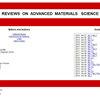砂-原砂比对含人造砂的土工聚合物砂浆机械性能和耐久性的影响
IF 3.6
4区 材料科学
Q2 MATERIALS SCIENCE, MULTIDISCIPLINARY
引用次数: 0
摘要
由工业副产品和碱活化液(AAS)制备的土工聚合物砂浆(GPM)是当前建筑材料的热点之一。人工砂(MS)作为天然河砂的可行替代品,可减轻全球生态压力。本研究使用人造砂作为细骨料。氢氧化钠(NaOH)和硅酸钠(Na2SiO3)溶液用作 AAS。以偏高岭土(MK)和粉煤灰(FA)为前驱体,制备以 MK-FA 为基础的 GPM 与 MS(MS-GPM),这对于节约不可再生资源、减轻温室效应和废物回收利用具有重要意义。为探讨砂-前驱体比率(r sp)对 MS-GPM 的机械和耐久性能的影响,进行了大量研究。通过线性拟合方程建立了抗压强度与拉伸或弯曲强度之间的关系。最后,采用方差分析(ANOVA)系统地计算了 r sp 对性能的影响。结果表明,随着 r sp 从 1 到 5 的增加,MS-GPM 的机械强度和抗渗性降低,抗裂性增加。随着 r sp 的增大,MS-GPM 中 MS 的比例增大,相对胶凝材料减少,对机械强度和抗渗性产生不利影响。线性拟合结果表明,MS-GPM 的抗压强度与抗拉强度和抗折强度密切相关。方差分析结果表明,r sp 在 1-5 之间对 MS-GPM 的性能有很大影响。本文旨在通过设计合理的 r sp,进一步提高 MS-GPM 在实际工程中应用的可能性。本文章由计算机程序翻译,如有差异,请以英文原文为准。
Effect of sand–precursor ratio on mechanical properties and durability of geopolymer mortar with manufactured sand
The geopolymer mortar (GPM) prepared from industrial by-products and alkali activation solution (AAS) is one of the hot spots of current building materials. As a feasible alternative to natural river sand, manufactured sand (MS) alleviates the global ecological pressure. In this study, MS was used for fine aggregate. Sodium hydroxide (NaOH) and sodium silicate (Na2 SiO3 ) solution were used as AAS. Metakaolin (MK) and fly ash (FA) were used as the precursor to prepare MK-FA-based GPM with MS (MS-GPM), which was of great significance for saving non-renewable resources, mitigating the greenhouse effect, and recycling waste. Numerous studies were conducted to explore the effect of sand–precursor ratio (r sp ) on mechanical and durability characteristics of MS-GPM. Relationships between compressive strength and tensile or flexural strength were established by linear fitting equation. Finally, analysis of variance (ANOVA) was used to systematically calculate the effect of r sp on performance. The results indicated that the mechanical strength and impermeability of MS-GPM decreased and crack resistance increased with r sp from 1 to 5. The strength of MS-GPM was the best when r sp was 1. With the increase of r sp , the proportion of MS in MS-GPM increases, and the relative cementitious material decreases, which has an adverse impact on mechanical properties and impermeability. Linear fitting revealed that the compressive strength of MS-GPM was closely related to tensile strength and flexural strength. ANOVA results indicated that r sp in the range of 1–5 had great effects on the performance of MS-GPM. The aim of this article is to further promote the possibility of applying MS-GPM in practical engineering by designing reasonable r sp .
求助全文
通过发布文献求助,成功后即可免费获取论文全文。
去求助
来源期刊

Reviews on Advanced Materials Science
工程技术-材料科学:综合
CiteScore
5.10
自引率
11.10%
发文量
43
审稿时长
3.5 months
期刊介绍:
Reviews on Advanced Materials Science is a fully peer-reviewed, open access, electronic journal that publishes significant, original and relevant works in the area of theoretical and experimental studies of advanced materials. The journal provides the readers with free, instant, and permanent access to all content worldwide; and the authors with extensive promotion of published articles, long-time preservation, language-correction services, no space constraints and immediate publication.
Reviews on Advanced Materials Science is listed inter alia by Clarivate Analytics (formerly Thomson Reuters) - Current Contents/Physical, Chemical, and Earth Sciences (CC/PC&ES), JCR and SCIE. Our standard policy requires each paper to be reviewed by at least two Referees and the peer-review process is single-blind.
 求助内容:
求助内容: 应助结果提醒方式:
应助结果提醒方式:


